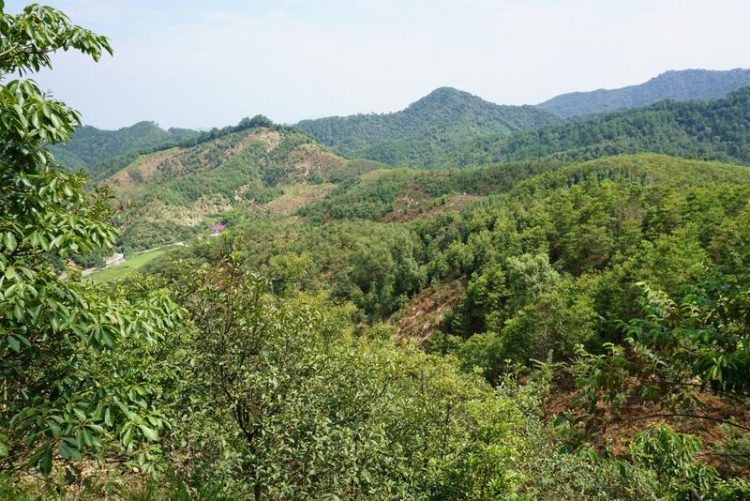“How trees coexist” – new findings from biodiversity research published in Nature Communications

Tree diversity experiment BEF-China, September 2016 Goddert von Oheimb
Writing in Nature Communications (https://www.nature.com/articles/s41467-018-03529-w) ecologists from TU Dresden in cooperation with the Leuphana University Lüneburg, the Martin-Luther-University Halle-Wittenberg, the Beijing Forestry University and the German Centre for integrative Biodiversity Research (iDiv, Leipzig) now report that this view is generally not wrong, but our understanding of how trees interact is still limited.
For a decade, researchers explore how tree species diversity affects the coexistence of trees and their growth performance in the largest biodiversity experiment with trees worldwide, the so-called ‘BEF-China’ experiment. One of the main interests of the BEF-China team is to explore the relationship between tree diversity and multiple ecosystem functions, specifically those benefitting society, such as wood production or the mitigation of soil erosion.
For this purpose, an experimental site of c. 50 hectare in subtropical China was planted with more than 400,000 trees and shrubs. Trees have achieved a height of 10 to 15 m and their crowns have formed a dense canopy by that time.
The findings now shed new light on tree-tree interactions: The local environment of a tree strongly determine its productivity, meaning that tree individuals growing in a species-rich neighbourhood produce more wood than those surrounded by neighbours of the same species.
„Particularly impressive is the finding that the interrelations of a tree with its immediate neighbours induce higher productivity of the entire tree community (i.e. the forest stand), and that such local neighbourhood interactions explain more than 50% of the total forest stand productivity”, says forest ecologist Dr. Andreas Fichtner.
The importance of local neighbourhood interactions in regulating forest stand productivity increases as forest stands were richer in tree species. These findings show that the coexistence of neighbouring trees and their small-scale interactions are substantial in explaining the productivity of species-rich mixed forests.
The scientists were also able to identify mechanisms explaining why species-rich neighbourhoods promote tree productivity. Their findings show that competition is less prevalent in species-rich neighbourhoods and that species-rich neighbourhoods can even lead to facilitation by e.g. an improvement of the microclimatic conditions or by positive interactions with soil fungi.
„These findings contribute to a deeper understanding of tree interactions and the functioning of forest ecosystems, and are particularly relevant for nature conservation and forestry”, says Prof. Dr. Goddert von Oheimb from the Department of Forest Sciences at the TU Dresden.
For instance, afforestation programs in countries that have experienced dramatic deforestation in the past, may benefit from planting multiple native tree species at the smallest spatial scale (i.e., the local neighbourhood level) instead of planting monocultures or mixing monospecific patches at larger spatial scales. Furthermore, the study emphasizes the importance of long-term measures preserving global biodiversity.
This in turn will benefit the multifunctionality of forest ecosystems and their associated ecosystem services benefitting the society. “This shows that biodiversity conservation is not exclusively an ecological or ethical issue, but rather a necessity ensuring socio-economic welfare”, says Dr. Andreas Fichtner.
Original publication:
Andreas Fichtner, Werner Härdtle, Helge Bruelheide, Matthias Kunz, Ying Li, Goddert von Oheimb (2018): Neighbourhood interactions drive overyielding in mixed-species tree communities. Nature Communications 9:1144. DOI: 10.1038/ s41467-018-03529-w
Media inquiries:
Prof. Goddert von Oheimb
Tel.: +49 (0) 351 463-31288
Email: Goddert_v_Oheimb@tu-dresden.de
(further information can be found under http://www.bef-china.de/index.php/en/)
https://www.nature.com/articles/s41467-018-03529-w
http://www.bef-china.de/index.php/en/
Media Contact
All latest news from the category: Agricultural and Forestry Science
Newest articles

First-of-its-kind study uses remote sensing to monitor plastic debris in rivers and lakes
Remote sensing creates a cost-effective solution to monitoring plastic pollution. A first-of-its-kind study from researchers at the University of Minnesota Twin Cities shows how remote sensing can help monitor and…

Laser-based artificial neuron mimics nerve cell functions at lightning speed
With a processing speed a billion times faster than nature, chip-based laser neuron could help advance AI tasks such as pattern recognition and sequence prediction. Researchers have developed a laser-based…

Optimising the processing of plastic waste
Just one look in the yellow bin reveals a colourful jumble of different types of plastic. However, the purer and more uniform plastic waste is, the easier it is to…



